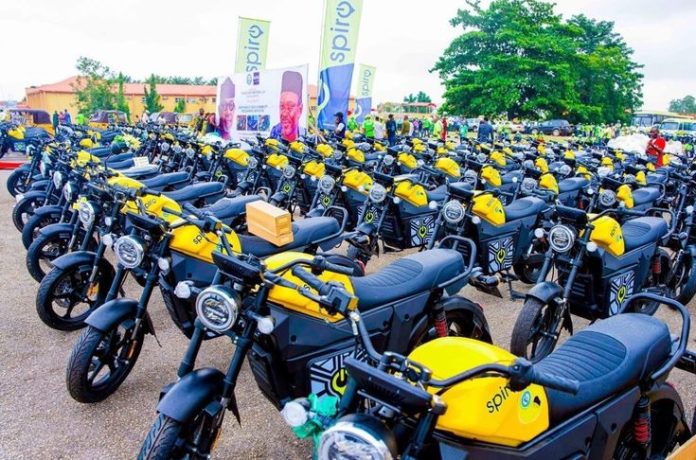Spiro, a Nairobi-headquartered electric two-wheel mobility company backed from Dubai and Africa, has closed a $100 million funding round led by Afreximbank’s Fund for Export Development in Africa (FEDA). The cash will be used immediately to scale battery-swapping infrastructure and vehicle production across existing markets; Kenya, Uganda, Rwanda, Nigeria, Benin and Togo, and to accelerate pilots in Tanzania and Cameroon, with the company publicly targeting more than 100,000 deployed electric motorbikes by the end of 2025.
The deal, announced this October (2025), is being framed as a strategic push to cut transport costs, cut emissions and build local manufacturing capacity across the continent, using the battery-swap model as the operational lever.
This promising development is a bet on converting tens of thousands of daily, revenue-driven riders th;e boda-boda and okada economies; from petrol to electric in markets where mobility is both livelihood and last-mile lifeline.
Read also: Kenya Airways flies first African route, from Nairobi to Cape Town, on sustainable fuel
Spiro’s model pairs affordable hardware (bikes that company communications put roughly in the $800–$1,000 range) with a dense network of swap stations so riders do not wait hours for a charge. That combination addresses three practical barriers that have stalled EV adoption in Africa: upfront cost, downtime, and power reliability. Investors appear to have read the same arithmetic: lower operating costs and less idle time translate to higher daily take-home pay for drivers, and that is what drives rapid behaviour change on these streets.
The company’s public figures; deployed fleets north of 60,000 bikes and between roughly 1,200 and 1,500 swap stations across six countries, are already producing measurable effects: battery swaps have grown from a few million in 2022 to more than 25–27 million swaps in 2025, a proxy for usage intensity that can be translated into kilometers travelled and diesel avoided. Management and some analysts say riders can save around $3 per day on fuel and maintenance versus petrol equivalents; multiply that across tens of thousands of riders and you see immediate household impact and a rapid payback profile for many customers.

Replacing high-emission two-stroke and four-stroke petrol motorcycles at scale reduces urban and peri-urban particulate and NOx loads that exacerbate respiratory disease, and eases demand for imported fuel. But the environmental dividend will only materialize if the electricity used to charge and swap batteries is progressively decarbonized and if batteries are managed as an industrial asset rather than waste.
Spiro’s stated plan to integrate renewables into its swap-station grid and to increase local battery manufacturing from roughly 30 percent local content today toward a 70 percent target by 2027 signals an awareness of the full value chain, manufacturing jobs, supply-chain localization, and end-of-life management, that moves the project from pilot to industrial policy. Those targets, if met, create domestic industrial multipliers and reduce foreign exchange pressure on economies that import both fuel and finished vehicles.
Still, the arithmetic hides risk. Rapid fleet deployment requires a parallel expansion in parts, battery cells, technical skills and servicing networks; batteries have finite lifespans and swapping depends on standardized packs and robust monitoring systems.
Read also: OPEC fund commits $31 million to boost energy and food security in Chad
As fleets age, financing models will soon be tested: who owns the batteries, who guarantees replacement, and how will secondary markets for used batteries be regulated so that recyclers, not informal dumpers, capture value?
Spiro’s push to scale assembly to perhaps 15,000 bikes per month and its ambition to lift local sourcing are answers in progress, not completed solutions. They will require predictable tariffs, coordinated industrial policy and financing mechanisms that preserve affordability for riders while keeping unit economics sensible for the operator.
Across Africa the implications will vary by country. In Nigeria and Kenya, where urban congestion and higher per-kilometre incomes make operating savings more compelling, electrification can diffuse quickly and create local manufacturing opportunities. In smaller markets such as Benin and Togo, the impact is about proving models and creating logistics corridors.
In countries with weak grids, swap stations act as microgrids and may be the visible on-ramp for distributed renewables, but they will also compete for scarce capital and require partnership with utilities. For Tanzania and Cameroon, where pilots are underway, success will depend on regulatory clarity; permits, safety standards, and import duty regimes that either encourage local assembly or make the model unnecessarily expensive. The net result: coordinated policy that treats electrified two-wheelers as an industrial programme, not only an environmental subsidy, will determine whether these investments unlock broad societal benefit.
What does this mean for sustainability at large?
If the sector scales as Spiro and investors expect, we will see a measurable drop in tailpipe emissions from one of Africa’s most ubiquitous vehicle classes, while creating jobs from assembly lines to station technicians.
But the transition demands parallel systems: renewable charging, battery recycling infrastructure, finance for small operators, and training for technicians, all things that are often missing from headline funding rounds. This round does more than enlarge a balance sheet; it tests whether capital can translate into institutional capacity on the ground. If it can, the model becomes exportable across other transport segments and offers a template for public-private climate action that is pragmatic, visible and, crucially, financially sustainable.
Read also: Nigeria signs $435 million renewable energy investment deals to expand power access
In summary, the $100 million is a lever. It buys production lines, swap stations and scale, and it buys a clearer conversation in ministries about industrial policy and clean energy. Whether it buys cleaner air, more stable jobs and an enduring local industry depends on the next steps: how batteries are sourced and retired, how quickly grids green, and whether the savings that riders feel in their pockets translate into sustained market demand rather than a short-term subsidy effect.





